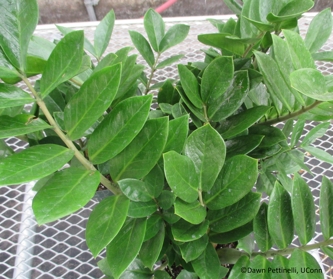Zamioculcas zamifolia
Zamioculcas zamifolia, also known as the ZZ plant, Zanzibar gem, Zuzu plant, and Emerald palm, is a medium-sized, attractive yet undemanding houseplant that will add a touch of green to indoor surroundings. Native to South Africa, the ZZ plant became a popular houseplant in the 1990s. The Dutch were among the first to propagate them and shipments sent to the United States were eagerly purchased.
Plants grow upright and feature graceful arching stems filled with fleshy, oval-shaped leaves giving plants an almost feather-like appearance. The stems thicken at the bottom as they arise from starchy rhizomes. Plants spread slowly but laterally adding stems as the plant ages. Stems are fairly strong and they may (as can be seen when plants are left in their pots too long and developing stems) push out and eventually crack the sides of pots. The ZZ plant has very few disease or insect issues and is known to improve air quality in a home by removing certain volatile compounds. See our fact sheet Houseplants for Healthier Indoor Air for additional information.

Light and Temperature Requirements
ZZ plants are moderate to slow growing depending on the cultural conditions. Greenhouse grown plants tend to grow more rapidly due to a generous supply of bright indirect light, fertilizer and water. Plant growth is much slower in lower light conditions found in many homes. Plants are happy in indirect light but will tolerate low light levels of natural light. They are even suited for a windowless office as long as exposed to fluorescent lights for several hours each day.
ZZ plants will not tolerate direct sunlight except perhaps an eastern exposure during the winter months. Too much direct light will cause scalding (a whitening) of leaves and leaves may curl. Leaves exposed to too much light may yellow and then brown. Also stems may change positions to bend away from the light which is the opposite of how most plants behave. Those with higher light requirements typically bend towards the light. If you notice any of these symptoms, move your ZZ plant to a more indirectly lit location. Keep ZZ plants between 55°F and 80° F. Plants will grow more rapidly at warmer temperatures.
Watering Requirements
Because of their fleshy rhizomes, ZZ plants can store a fair amount of water. Plants should be watered sparingly. Allow to dry slightly between waterings. When in doubt about whether to water or not, err on the dry side. Overwatering is just about the only factor that leads to the demise of this tough houseplant. Signs of overwatering are yellow leaves and rotting rhizomes. See our fact sheet Houseplant Watering Recommendations for additional information.
Fertilizer Requirements
During the growing season plants can be fertilized once or twice. Use a balanced houseplant fertilizer diluted to half-strength or fertilizeonce evry six months at full strength. Sometimes in late summer small brownish to yellow flowers appear. See our fact sheet Houseplant Fertilization for additional information.
Propagation
If you would like to make more ZZ plants, try rooting some leaf cuttings. Whole leaves can be removed from a stem and left sitting out for a few hours for the cut area to callous over. Then push the stem part way into moist soilless potting medium. Keep the soil moist and place it where it will receive indirect light. Under greenhouse conditions, small rhizomes start forming at the bottom of the leaves in about a month. More typically under indoor household conditions it may take up to 9 months for the rhizome to start to form.
Toxicity
ZZ plants are members of the Aroid family which also includes Jack-in-the-pulpit and skunk cabbage. Many members of this family contain calcium oxalate crystals which can be extremely painful and damaging to soft tissues in the mouth and throat. As a precaution, make sure plants are not in areas where small children or pets might be able to sample them. For additional information please see Houseplants: Safe and Toxic Varieties.
Varieties
At this time only two cultivars are available. The most common one has beautiful green, waxy leaves while ‘Raven’ is noted for its very dark green, almost black foliage. ZZ plants’ tolerance for low-light and moisture conditions make them valuable houseplants.
Despite good cultural practices, pests and diseases at times may appear. Chemical control should be used only after all other methods have failed. For pesticide information or other questions please call toll free: 877-486-6271.
UConn Home and Garden Education Center, 2019